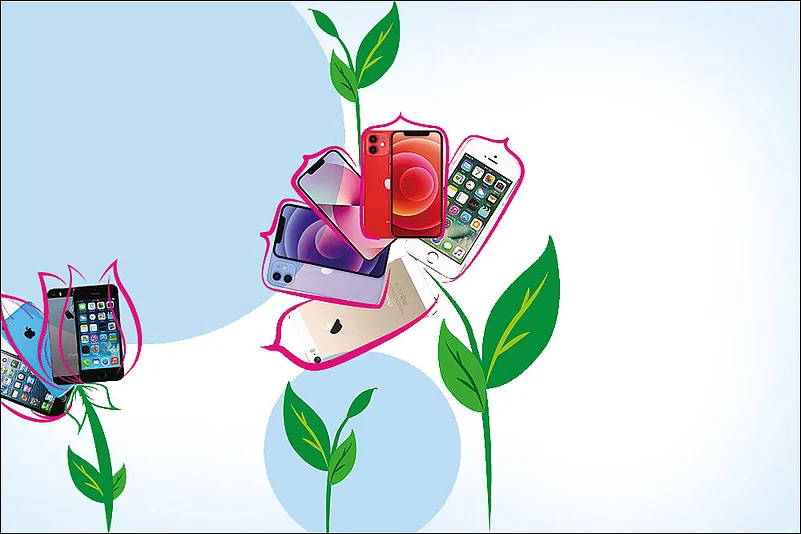Though Mumbai-based banker Vishnu Nair does not engage with all features of an iPhone, he has religiously purchased almost every model since iPhone 5 was launched. He has a collection of each of his acquisitions. He claims to be the first one to get an iPhone 10 Pro Max in Kerala’s Alleppey district. So strong is his loyalty to the brand that he has convinced over a dozen colleagues to switch to iPhone.
His friend Sarath Viswam is even a bigger enthusiast who leans on his contacts in Dubai and Abu Dhabi to get the latest model within a day of the launch. Much like Ahmedabad-based Dr Shivam Poddar. Three of the five iPhones the radiologist owned in the past decade were purchased on the day of launch.
Nair, Viswam and Poddar represent the growing user community which cannot see beyond iPhone when it thinks of smartphones.
Hooked on to iPhone
Navkendar Singh, associate vice president, devices research at IDC India, South Asia and ANZ, says that Apple shipment in India stood at 2.8 million in 2020 and 4.8 million in 2021 and is expected to exit 2022 with 6.5 million units, which testify to their increasing popularity in a country that is obsessed with affordable Android devices.
Industry analysis firm Counterpoint says that 2021 was Apple’s best year in the country when it hit shipment between 5.4 to six million. Counterpoint’s research shows that 2018 and 2019 were flat years for iPhone in India with sales under two million in each year. The next year saw decent growth with sales of around three million units, but it exploded in 2021. Though the official full-year sales figures for 2022 are not available, in an earnings call for the September quarter of 2022, top Apple leadership, including its CEO Tim Cook, lauded the company’s performance in India. Its CFO Luca Maestri said, “iPhone revenue grew 10% year over year to a September quarter record of $42.6 billion, despite significant foreign exchange headwinds ... our performance was particularly impressive in several large emerging markets, with India setting a new all-time revenue record ... .”
The overall smartphone shipment in the country declined by 11% YoY at 45 million units in the September quarter of FY22, according to Counterpoint.
Analyst firm Techarc claimed in September 2022 that the 2022 sales of iPhone in India were set to touch the seven million mark in a countrywide smartphone shipment of 162 million. For iPhone, this figure will be a growth of 140 times since 2008 when it was officially launched and sold just 50,000 units. In contrast, the Indian smartphone market grew 47 times in this period.
A Premium Prize
India is, by and large, an Android market in the smartphone category. In a price-sensitive country, Apple’s products are seen as indulgence by market watchers, which probably will not contribute a significant share to the revenue of the most valuable company in the world.
While Apple’s Indian revenue stays small in its global balance sheet—Apple shipped 237.9 million iPhones in 2021 globally in comparison, according to Counterpoint—things are moving fast for at least iPhone in India, if not for Apple’s other products. The upswing in iPhone sales in the last two years becomes important in the backdrop of overall decline in the smartphone market in India. Market research firm Canalys estimates that in 2022, India registered a fall of around 6% in the smartphone shipment at 151.6 million units over 2021. Incidentally, the major drop took place in the December quarter of CY22 at 27%, which followed a 6% drop in the September quarter. Counterpoint, however, noted that iPhone 13 was the top-shipped brand in the September quarter of 2022, a first for any iPhone model in India, which it attributed to the high demand for 5G handsets in the country. This trend continued in the December quarter, when iPhone 13 became the highest selling model in India for any brand with a 4% share in total sales, beating other top models like Samsung Galaxy M13, Xiaomi Redmi A1, Samsung Galaxy A04S and Realme C35, all of which stayed at 3%.

The drop in the smartphone sales in India has been attributed to a variety of reasons, including low consumer confidence, inflation, a slower pace of economic growth, etc., but the popularity of iPhone is being seen as an outcome of Apple putting its operations in order, having a better relationship with vendors and an increase in showroom strength.
Brand Pride
While most smartphone brands have been impacted in the last two years, especially in the entry-tier and budget segments, the premium category was not that badly impacted. And, in this segment, Apple has always enjoyed a strong brand salience and equity amongst consumers. “Driven by the enduring aspirational appeal of iPhones, consumers have continued to seek the latest iPhones as a lifestyle statement, as well as a gateway to the vast Apple ecosystem of hardware and services,” says Prabhu Ram, head of industry intelligence group at CyberMedia Research.
Typically, the above Rs 50,000 smartphone market has largely been a two-horse race between Samsung and Apple, and thus also between Android and iOS. However, Apple loyalists are unlikelier to move to an Android device, while the latter make the switchover more easily. Praveen Jain, partner at Mumbai’s Maxell mobile store, explains the consumer mindset succinctly: “Of course, owning an iPhone is a status symbol. But, more than that, most of our customers love it for its UX and security features. The phone is so secure that it prevents access without a correct passcode or fingerprint.” He adds that till a few years ago, he would get around 10 to 15 iPhone buyers a month, however the number has quadrupled now and is going up.
For users who move from Android to iOS, the company has a term—“switchers”—which finds repeated mention in its earnings calls. In the earnings call at the end of the June quarter in 2022, Maestri said, “In fact, the latest survey of US consumers from 451 Research indicates iPhone customer satisfaction of 98%. We also attracted a record number of switchers for the June quarter, with strong double-digit year-over-year growth.”
Apple seems to have learnt from its mistakes in India and has worked aggressively on fixing the financing options for buyers. Even people who can afford to buy the latest iPhone upfront prefer to purchase it on credit and then pay zero-interest EMIs over a few months. It took Ahmedabad-based Sourabh Kori, who works remotely as a UX designer for a Bengaluru-based SaaS company, a while to convince his Android-loving father to switch to iPhone. He went for iPhone 14 Pro. However, despite being in a position to pay upfront, he purchased the premium phone on credit because, in his own words, “paying such an amount upfront is a bad financial decision” and the zero-interest EMIs on the phone made more sense.
For the iPhone loyalist, the price that an average user would find exorbitant does not seem to be an obstacle. Reliability is the deal clincher for Kori. “My iPhone once had a freefall from the second floor of my college, but there was no damage to it at all. That is when I knew I would never part ways with this brand,” he says.
Aruna Ramachandran, vice president at JP Morgan Chase in Bengaluru, could not agree more. Like Kori, she finds the iPhone sturdy and reliable. “Over the years, I have become extremely comfortable with iPhone. The phones are sturdy and do not need to be replaced as often as Android phones,” she says.
CyberMedia Research’s insights point to the premium smartphone market in India being immune to inflationary pressures through the pandemic, something that Counterpoint’s Prachir Singh agrees with. “Generally, brand loyalty is one aspect that consumers focus on in the premium smartphone segment, followed by the product’s UI and security. Apple has always been an aspirational brand for consumers in India,” he notes.
After the global launch of iPhone 14 Pro and Pro Max last year, iPhone loyalists were waiting to lay their hands on the new models in India, but the stocks were unavailable. Maxell’s Jain claims that the wait time for both models shot up to over 25 days. This shortage was caused by supply chain disruptions following the rising Covid-19 cases and related restrictions in China. What followed was a mass exodus of workers from iPhone maker Foxconn’s main plant in Zhengzhou in November alleging poor living conditions at the facility as well as low pay scales.
The India-iPhone Coupling
CyberMedia Research’s Ram believes that consumer demand for iPhone 14 Pro and Pro Max outstripped Apple’s expectations. “While that may seemingly spell good news, close to 80% of global iPhone 14 Pro and Pro Max production is concentrated at Zhengzhou, China. The persistent supply chain constraints and Covid-19 surge in China impacted the production of Pro models, leading to longer-than-usual wait times in India and everywhere else,” he adds.

Apple started pushing its older generation iPhones at affordable discounts to bridge the supply gap for iPhone 14 models in India, a fact which is borne out by the iPhone 13 sales in the last two quarters of 2022.
India has become a curious market for iPhone where Apple has started implementing a China-like strategy. Like in China, Apple wants to build on the sizeable Indian userbase of iPhone by mounting an export strategy from here that can have the potential to solve its China troubles. This is a significant reason why India is an emerging sweet spot for Apple’s manufacturing plans for iPhone. IDC India’s Navkendar Singh says, “India’s large population and massive smartphone base, averaging 650 million users with around 150 million annual shipments, gives it a natural advantage.”
However, he cautions that it is not time to bring out the pom-poms yet. “We must keep in mind that for Apple, which is seen as a super premium brand in India with less than 5% market share (with an average selling price of $1,000 versus average market selling price of $250), domestic demand will not be a deciding factor,” he elaborates.
Three factors have clearly coalesced into giving iPhone a fillip in India—the sales boost in 2021 and 2022 when the smartphone market seemed to be stagnating, Foxconn’s troubles in China due to stringent Covid-19 protocols and the resulting workers’ unrest and India’s push for manufacturing through Make in India approach.
India and iPhone appear as net gainers of China Plus One strategy of global corporations that is the result of both adversarial geopolitics between China and the US-led Western bloc as well as the restraints forced by the aftermath of Covid-19. Apple already has a head start as it assembles iPhone 11, 12 and 13 in India through Taiwanese companies Foxconn, Wistron and Pegatron. In September 2022, it took the next logical step when it said, “We’re excited to be manufacturing iPhone 14 in India.”
Counterpoint predicts that by 2025, 18% to 20% of all iPhones globally will be made in India, which will be a huge step up from its production at around 3% in 2021 and 5% in 2022. JPMorgan expects this figure to reach 25% by the same time. In 2022, China produced as much as 85% of total global iPhone shipments.
CyberMedia Research’s Ram feels that with more upstream and downstream supply chain integration in the offing, India’s “audacious electronics manufacturing gambit will win on its own merits instead of a mere China Plus One positioning”. He adds that his company’s insights already point to an increasing growth in smartphone exports from India to Western markets and the traditional developing markets in recent years.
A recent Bloomberg report seconded Ram’s claim. It said that from April to December 2022, iPhone manufacturers Foxconn and Wistron doubled the value of their total exports from FY21 to hit $1 billion each and the other manufacturer Pegatron was set to achieve the export value $500 million by the end of January 2023.

The China Plus One strategy apart, the factors that can give Apple’s manufacturing plans in India a big push will be creating an ecosystem that enables it to produce at scale by syncing in ancillary suppliers and creating a pool of skilled labour and the right kind of infrastructure. Foxconn has already entered into a joint venture with Vedanta to build a semiconductor unit in Gujarat, but analysts feel that Apple still has many ends to tie to build on India’s domestic market and turn it into an export hub, like China.
A Bloomberg Intelligence survey of Apple’s global supply chain is apprehensive about the success of Apple’s plans to move a substantial part of its production to India and Vietnam due to a heavy concentration of its suppliers in China. It analysed Apple’s global suppliers list to conclude that China has 2,360 supplier facilities out of a total of 12,248, while India has only 278 and Vietnam 160. Only the US has more supplier facilities than China at 2,481.
Bloomberg Intelligence estimates that for 10% of Apple production—not just iPhone production—to move away from China, it will take eight years. Singh partially mirrors this thought when he makes estimates about India’s share in iPhone production. He says, “India’s manufacturing currently contributes less than 5% for Apple and could surpass 10% during 2022. It might go up to 30% in the next three to four years if all pieces of the puzzle come together for the company and India.”
This is where the government’s much touted production-linked incentives could come into play. The Tata Group has shown interest in buying the Karnataka facility of Wistron. If it falls in place, the Tata Group could emerge as a strategic partner in the Apple supply chain which has the experience of executing at scale, a quality that China lures global manufacturers with. Coupled with the size of the Indian smartphone market and the brand value of iPhone, one can say that it has consolidated enough in India to be able to seriously test export markets from its domestic production facilities.


























